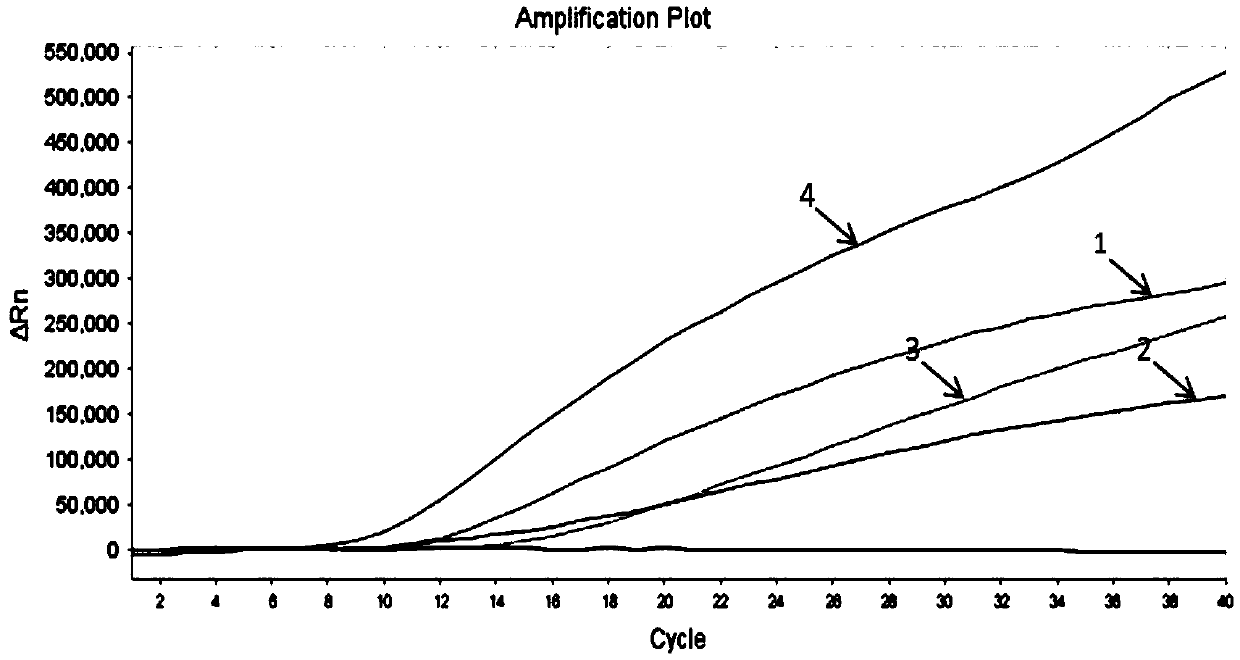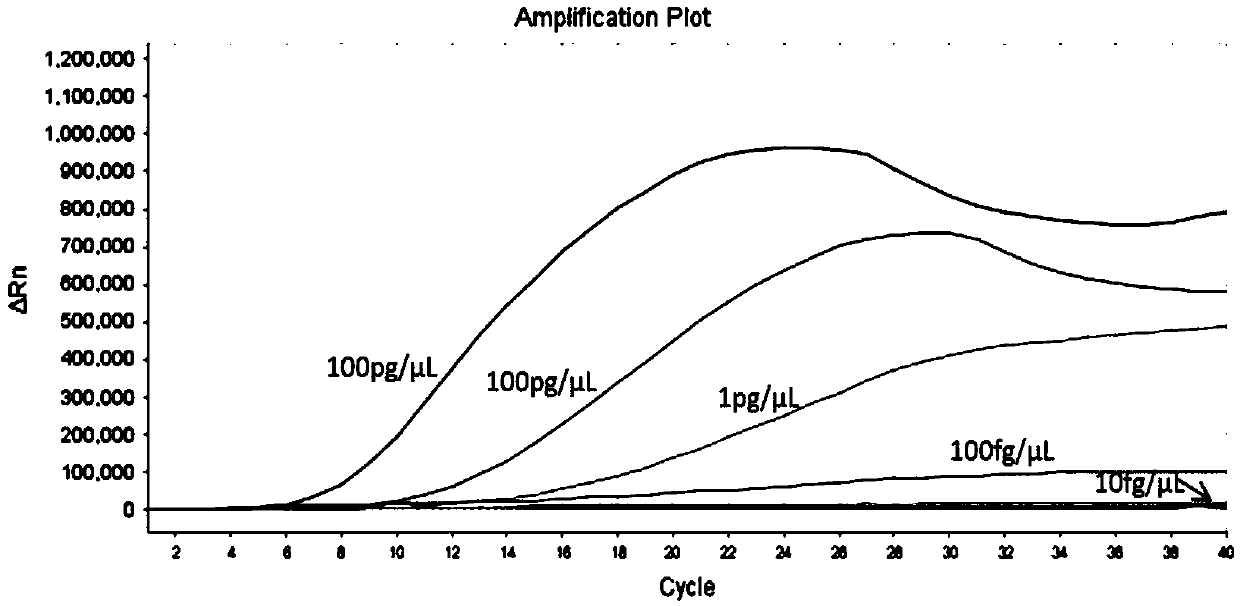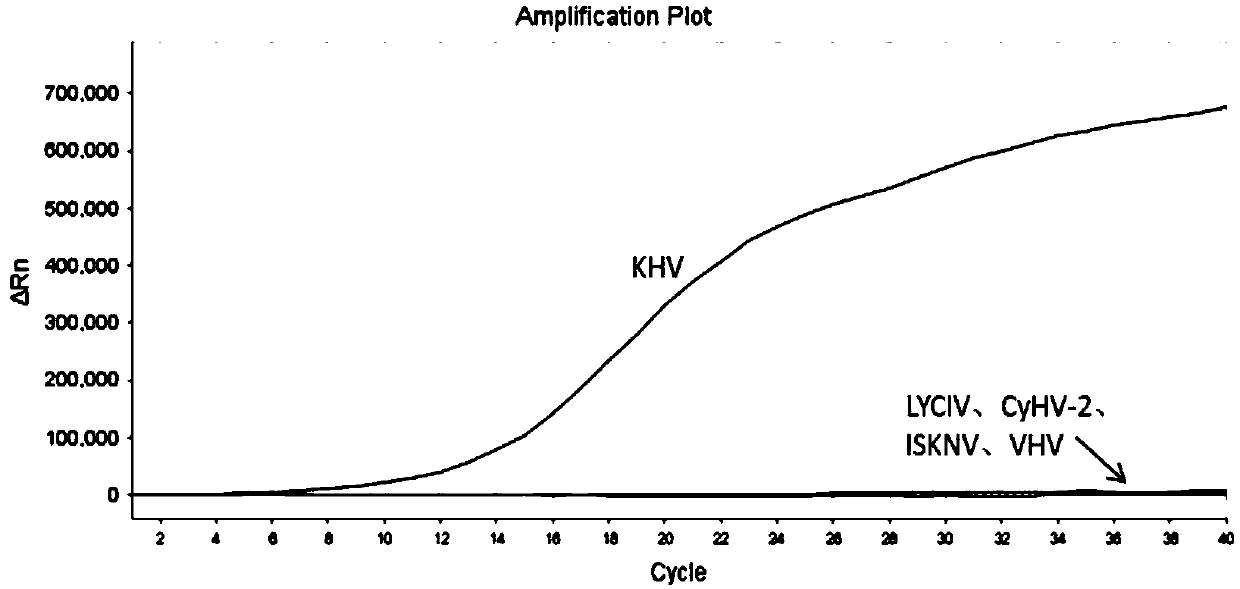Recombinase-aid amplification (RAA) constant-temperature fluorescence detection method and reagent for Koi herpesvirus (KHV)
A koi herpes virus and detection kit technology, applied in the field of molecular biology, can solve the problems of high false positives, limited application, and few, and achieve the effects of high sensitivity, simple identification, and simple operation
- Summary
- Abstract
- Description
- Claims
- Application Information
AI Technical Summary
Problems solved by technology
Method used
Image
Examples
Embodiment 1
[0029] The present invention searches the TK gene sequence of the koi herpes virus in the Genebank database, uses DNAMAN 6.0 software to compare multiple sequences, and finds out the conserved segment. Four sets of primers and probes were designed in the conserved regions, and BLAST comparison was performed in the NCBI database. The sequences of the primers and probes are shown in Table 1. The positive sample amplification curve is as follows figure 1 shown.
[0030] Table 1 Primer and probe sequences:
[0031]
[0032] Depend on figure 1 The results show that the amplification curves of the fourth group of primers and probes are the most typical, with obvious exponential phase and plateau phase, higher fluorescence intensity (ordinate value), and smaller CT value (the intersection of the curve and the threshold line Corresponding abscissa) result analysis is shown in Table 2. For other primers and probes, the rising height of the curve is lower, the CT value is larger,...
Embodiment 2
[0035] Embodiment 2: The kit koi herpes virus
[0036] The nucleic acid detection kit of the present invention also includes primer mixture, specific fluorescent probe, ABuffer, BBuffer, RAA dry powder reagent, koi herpes virus standard and ddH 2 O.
[0037] In the kit of the present invention, the A Buffer is 20% PEG; the B Buffer is 280mM MgAc.
[0038]The kit of the present invention, wherein, the composition of the RAA dry powder reagent is as follows: 1mmol / L dNTP, 90ng / μL SSB protein, 120ng / μL recA recombinase protein (SC-recA / BS-recA) or 30ng / L μL Rad51, 30ng / μL Bsu DNA polymerase, 100mmol / L Tricine, 20% PEG, 5mmol / L dithiothreitol, 100ng / μL creatine kinase, Exo exonuclease.
[0039] In the primer mixture of the present invention, the base sequence of the forward primer is shown in SEQ ID NO.1, the base sequence of the reverse primer is shown in SEQ ID NO.2, the forward primer and reverse primer The molar ratio of the primers is 1:1 for SEQ ID NO.1:SEQ ID NO.2.
[0...
Embodiment 3
[0044] Embodiment 3: kit koi herpes virus of the present invention
[0045] 1. Extraction of positive sample nucleic acid
[0046] 1.1. Nucleic acid extraction: DNA extraction was performed using a marine animal tissue DNA extraction kit.
[0047] 2. The configuration of the RAA reaction system: each test sample corresponds to a RAA reaction dry powder tube, and the reaction components and the added volume in each RAA reaction dry powder tube are shown in Table 3.
[0048] table 3:
[0049] RAA reaction system components Volume (μL) A Buffer 12.5μL B Buffer 2.5μL primer mix 4μL specific fluorescent probe 0.6μL DNA template 2μL DEPC treated water 28.4μL total capacity 50μL
[0050] A Buffer is 20% PEG; B Buffer is 280mM MgAc
[0051] 3. Place the RAA reaction tube with the reaction system in the ABI7500 amplification instrument, and perform RAA amplification according to the following procedure: 37°C, 40s; 37°C...
PUM
 Login to View More
Login to View More Abstract
Description
Claims
Application Information
 Login to View More
Login to View More - R&D
- Intellectual Property
- Life Sciences
- Materials
- Tech Scout
- Unparalleled Data Quality
- Higher Quality Content
- 60% Fewer Hallucinations
Browse by: Latest US Patents, China's latest patents, Technical Efficacy Thesaurus, Application Domain, Technology Topic, Popular Technical Reports.
© 2025 PatSnap. All rights reserved.Legal|Privacy policy|Modern Slavery Act Transparency Statement|Sitemap|About US| Contact US: help@patsnap.com



